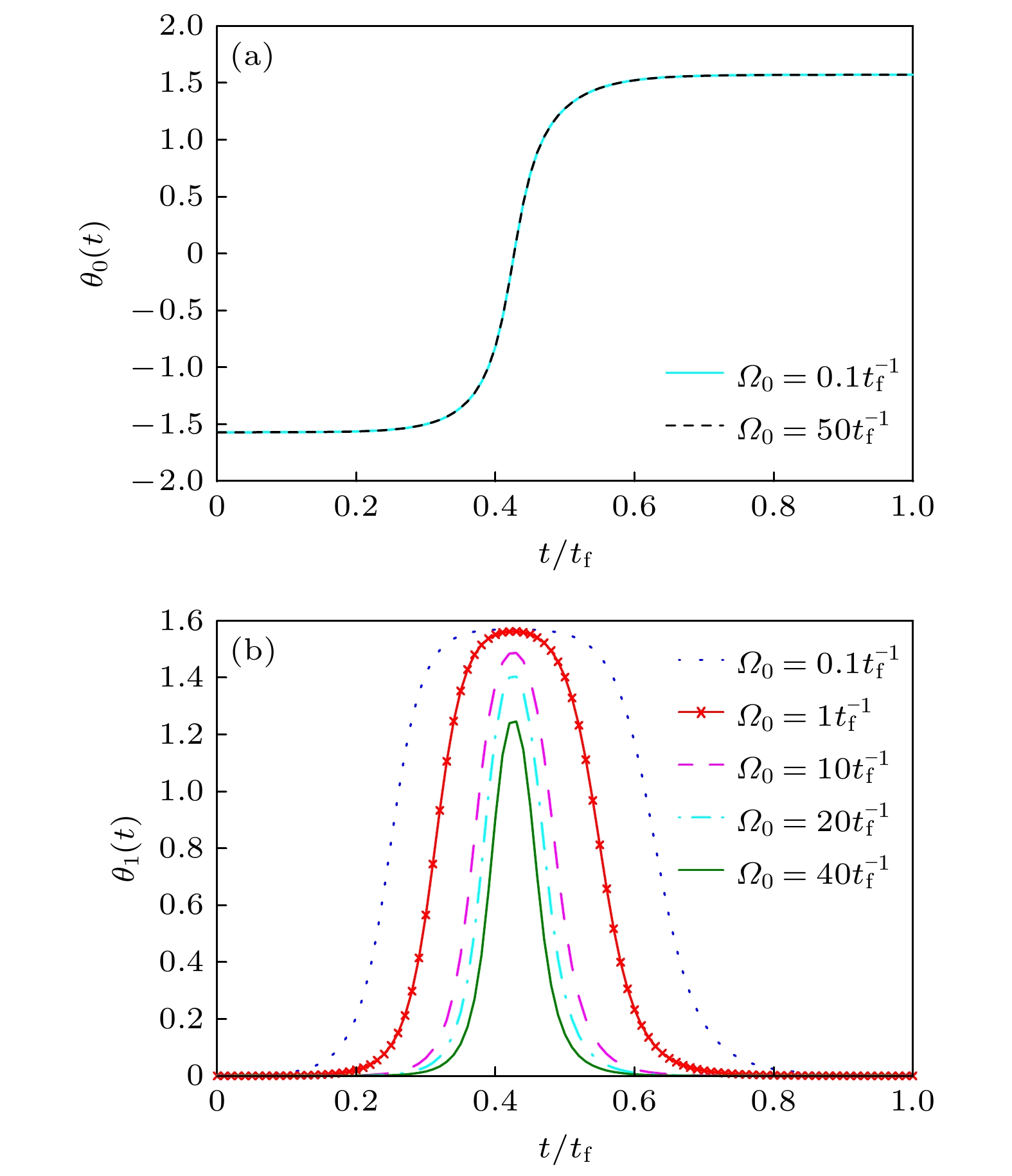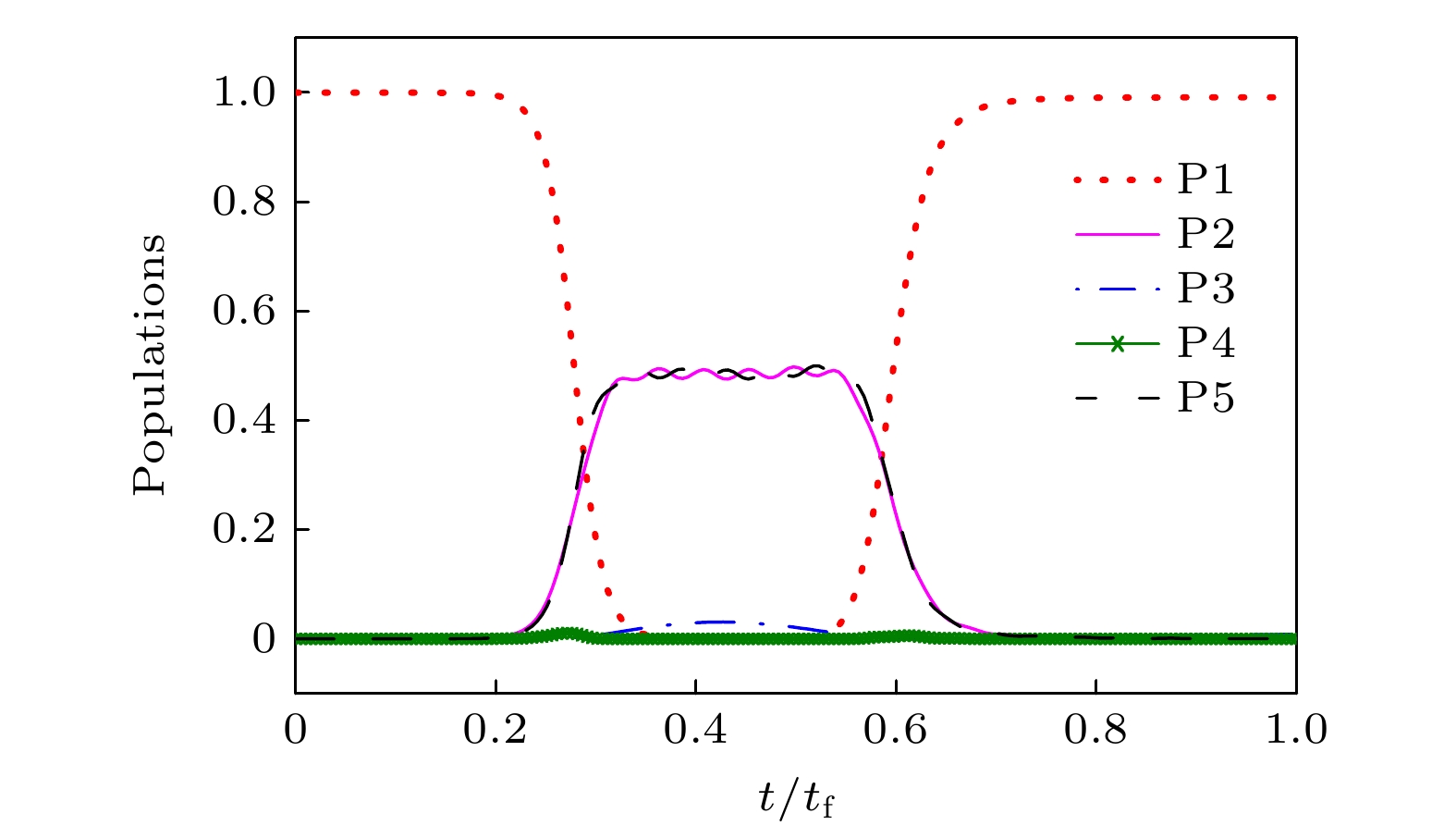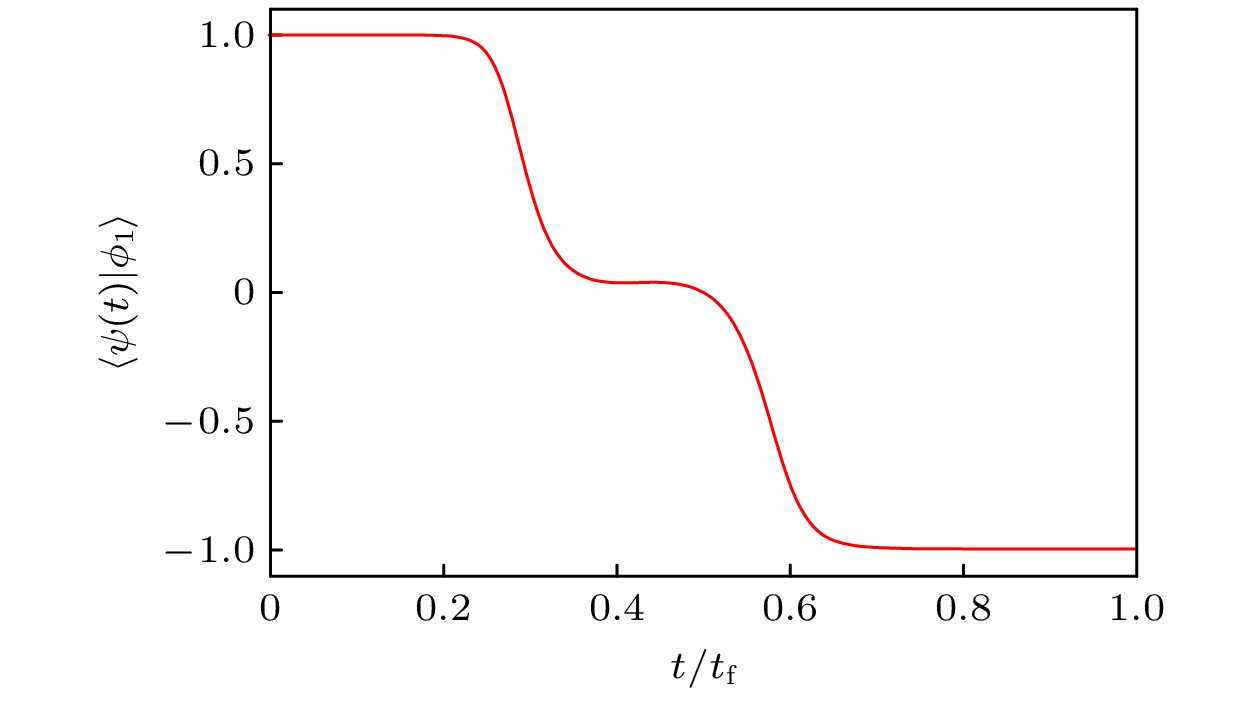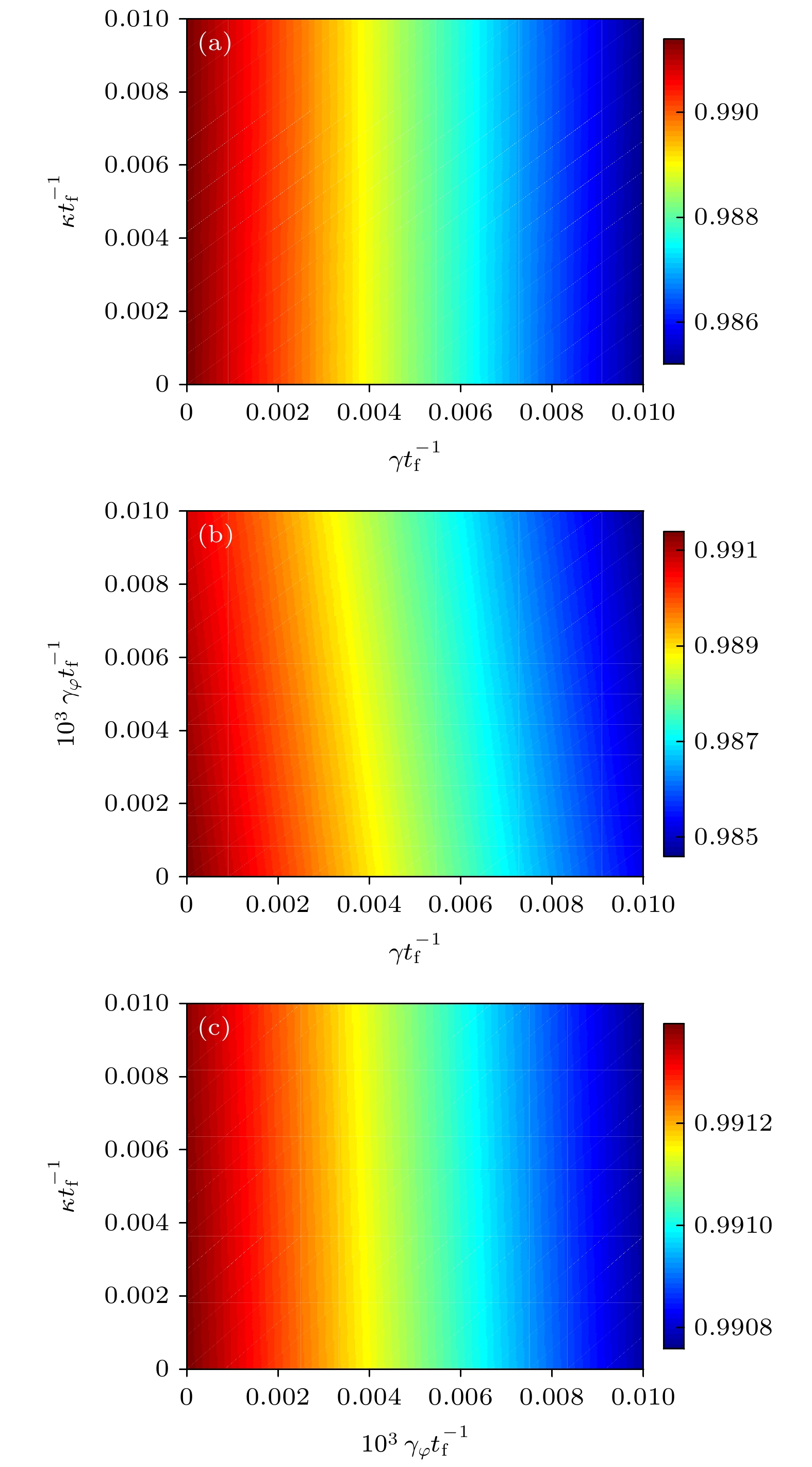-
With high speed and big storage power, quantum computer has received increasing attention. The operation on the quantum computer can be composed of several single-bit and multi-bit quantum logic gates, among which the controlled phase gate is one of the essential two-qubit logic gates. Usually, the quantum gate is realized in a real physical system, and the circuit quantum electrodynamics system (QED) has become a promising candidate due to its long coherent time, easily coupled with other physical system and scaled up to large scale. In this work, we propose a scheme to fast implement a two-qubit controlled phase gate based on the circuit QED by using the superadiabatic-based shortcut, in order to solve the problem that the adiabatic algorithm needs a long time in the process of system evolution. Here, a coding strategy is first designed for the circuit QED system and the two transmon qubits, and the effective Hamiltonian of the system is then presented by dividing different initial states in the rotating-wave approximation. By using the superadiabatic-based shortcut algorithm for two iterations, a correction term in the same form as the system effective Hamiltonian is obtained through anti-diabatic driving, so that the effective Hamiltonian can suppress unwanted transitions between different instantaneous eigenstates. According to the evolution path, the appropriate boundary conditions are also obtained to complete the preparation of the controlled phase gate. The numerical simulation results show the availability of the proposed scheme, that is, the
$ - \left| {11} \right\rangle $ state can be obtained by system evolution when the initial state is$ \left| {11} \right\rangle $ , while the system does not change at all when the other initial states are prepared. Furthermore, the controlled phase gate with high-fidelity can be obtained . It is shown that the fidelity of the controlled phase gate is stable and greater than 0.991 when the evolution time is greater than$0.7{t \mathord{\left/ {\vphantom {t {{t_f}}}} \right. } {{t_{\rm f}}}}$ . In addition, the proposed scheme can accelerate the evolution and is robust to decoherence. By the resonator decay and the spontaneous emission and dephasing of qubit, the final fidelity of the controlled phase gate is greater than 0.984. Since the controlled phase gate does not need additional parameters, the propsoed scheme is feasible in experiment.[1] Gong M, Wang S Y, Zha C, Chen M C, H L, Wu Y L, Zhu Q L, Zhao Y W, Li S W, Guo S J, Qian H R, Ye Y S, Chen F S, Ying C, Yu J L, Fan D J, Wu D H, Su H, Deng H, Rong H, Zhang K L, Cao S R, Lin J, Xu Y, Sun L H, Guo C, Li N, Liang F T, Bastidas V M, Nemoto K, Munro W J, Huo Y H, Lu C Y, Peng C Z, Zhu X B, Pan J W 2021 Science 372 948
 Google Scholar
Google Scholar
[2] Zhong H S, Wang H, Deng Y H, Chen M C, Peng L C, Luo Y H, Qin J, Wu D, Ding X, Hu Y, Hu P, Yang X Y, Zhang W J, Li H, Li Y X, Jiang X, Gan L, Yang G W, You L X, Wang Z, Li L, Liu N L, Lu C Y, Pan J W 2020 Science 370 1460
 Google Scholar
Google Scholar
[3] Preskill J 2018 Quantum 2 79
 Google Scholar
Google Scholar
[4] 刘超, 邬云文 2018 物理学报 67 170302
 Google Scholar
Google Scholar
Liu C, Wu Y W 2018 Acta Phys. Sin. 67 170302
 Google Scholar
Google Scholar
[5] Yu D M, Wang H, Ma D D, Zhao X D, Qian J 2019 Opt. Express 27 23080
 Google Scholar
Google Scholar
[6] Shi H M, Yu Y F, Zhang Z M 2012 Chin. Phys. B 21 064205
 Google Scholar
Google Scholar
[7] Liu G Q, Pan X Y 2018 Chin. Phys. B 27 020304
 Google Scholar
Google Scholar
[8] Wan Y, Kienzler D, Erickson S D, Mayer K H, Tan T R, Wu J J, Vasconcelos H M, Glancy S, Knill E, Wineland D J, Wilson A C, Leibfried D 2019 Science 364 875
 Google Scholar
Google Scholar
[9] Qiu C D, Ne X F, Lu D W 2021 Chin. Phys. B 30 048201
 Google Scholar
Google Scholar
[10] Zhang M, Wei L F 2012 Chin. Phys. Lett. 29 080301
 Google Scholar
Google Scholar
[11] Wen J W, Kong X Y, Wei S J, Wang B X, Xin T, Long G L 2019 Phys. Rev. A 99 012320
 Google Scholar
Google Scholar
[12] Zhang F Y, Pei P, Li C, Song H S 2011 Chin. Phys. Lett. 28 120304
 Google Scholar
Google Scholar
[13] Alqahtani M M 2020 Quantum Inf. Process. 19 12
 Google Scholar
Google Scholar
[14] Yang C P, Zheng Z F, Zhang Y 2018 Opt. Lett. 43 5765
 Google Scholar
Google Scholar
[15] Göppl M, Fragner A, Baur M, et al. 2008 J. Appl. Phys. 104 113904
 Google Scholar
Google Scholar
[16] Clarke J, Wilhelm F K 2008 Nature 453 1031
 Google Scholar
Google Scholar
[17] Wendin G 2017 Rep. Prog. Phys. 80 106001
 Google Scholar
Google Scholar
[18] Arute F, Arya K, Babbush R, et al. 2019 Nature 574 505
 Google Scholar
Google Scholar
[19] Huang H L, Wu D, Fan D, et al. 2020 Sci. China Inf. Sci. 63 180501
[20] Yang C P, Chu S I, Han S Y 2004 Phys. Rev. Lett. 92 117902
 Google Scholar
Google Scholar
[21] Wang X M, Zhang A Q, Xu P, Zhao S M 2021 Chin. Phys. B 30 030307
 Google Scholar
Google Scholar
[22] Wallraff A, Schuster D I, Blais A, et al. 2007 Phys. Rev. A 76 042319
 Google Scholar
Google Scholar
[23] Sangouard N, Lacour X, Guerin S, Jauslin H R 2005 Phys. Rev. A 72 062309
 Google Scholar
Google Scholar
[24] Zheng S B 2005 Phys. Rev. Lett. 95 080502
 Google Scholar
Google Scholar
[25] Shao X Q, Chen L, Zhang S, Yeon K H 2009 J. Phys. B 42 165507
 Google Scholar
Google Scholar
[26] Rousseaux B, Guerin S, Vitanov N V 2013 Phys. Rev. A 87 032328
 Google Scholar
Google Scholar
[27] Liang Y, Wu Q C, Su S L, Ji X, Zhang S 2015 Phys. Rev. A 91 032304
 Google Scholar
Google Scholar
[28] Liang Z T, Yue X X, Lv Q X, Du Y X, Huang W, Yan H, Zhu S L 2016 Phys. Rev. A 93 040305
 Google Scholar
Google Scholar
[29] Wang T H, Zhang Z X, Xiang L, Jia Z L, Duan P, Cai W Z, Gong Z H, Zong Z W, Wu M M, Wu J L, Sun L Y, Yin Y, Guo G P 2018 New J. Phys. 20 065003
 Google Scholar
Google Scholar
[30] Chu J, Li D Y, Yang X P, Song S Q, Han Z K, Yang Z, Dong Y Q, Zheng W, Wang Z M, Yu X M, Lan D, Tan X S, Yu Y 2020 Phys. Rev. A 13 064012
 Google Scholar
Google Scholar
[31] Spillane S M, Kippenberg T J, Painter O J, Vahala K J 2003 Phys. Rev. Lett. 91 043902
 Google Scholar
Google Scholar
[32] Spillane S M, Kippenberg T J, Vahala K J, Goh K W, Wilcut E, Kimble H J 2005 Phys. Rev. A 71 013817
 Google Scholar
Google Scholar
[33] Baksic A, Ribeiro H, Clerk A A 2016 Phys. Rev. Lett. 116 230503
 Google Scholar
Google Scholar
-
图 1 量子比特能级结构. qubit A和qubit B被囚禁在一个传输线性谐振器中, 每个量子比特拥有四个能级:
$ {\left| {{L_1}} \right\rangle _l} $ ,$ {\left| {{L_2}} \right\rangle _l} $ ,$ {\left| R \right\rangle _l} $ 和$ {\left| e \right\rangle _l} $ ,$ l = {\text{A, B}} $ , 其中$ {\left| e \right\rangle _l} $ 是辅助激发态. 有效信息被编码在$ {\left| {{L_1}} \right\rangle _l} $ ,$ {\left| {{L_2}} \right\rangle _l} $ 和$ {\left| R \right\rangle _l} $ 三个不同能级上. qubit A为控制比特, qubit B为受控比特.Figure 1. Structure of qubit energy level, qubit A and qubit B are fabricated in a transmission line resonator, each has four-level i.e.,
$ {\left| {{L_1}} \right\rangle _l} $ ,$ {\left| {{L_2}} \right\rangle _l} $ ,$ {\left| R \right\rangle _l} $ and$ {\left| e \right\rangle _l} $ ,$ l = {\text{A, B}} $ here,$ {\left| e \right\rangle _l} $ is an auxiliary excited state. The information is encoded on the states$ {\left| {{L_1}} \right\rangle _l} $ ,$ {\left| {{L_2}} \right\rangle _l} $ and$ {\left| R \right\rangle _l} $ . Qubit A is a controlling qubit, and qubit B is a controlled qubit.图 2 (a) 脉冲幅度取不同值时, 参数
$ {\theta _0}\left( t \right) $ 随时间的变化情况;$ {\varOmega _0} = 0.1 t_{\text{f}}^{ - 1} $ (黑色虚线),${\varOmega _0} = 50 t_{\text{f}}^{{{ - 1}}}$ (浅绿色实线); (b) 脉冲幅度取不同值时, 参数$ {\theta _1}(t) $ 随时间的变化情况;$ {\varOmega _0} = 0.1 t_f^{ - 1} $ (蓝色),$ {\varOmega _0} = 1 t_{\text{f}}^{ - 1} $ (红色),$ {\varOmega _0} = 10 t_{\text{f}}^{ - 1} $ (粉色),$ {\varOmega _0} = 20 t_{\text{f}}^{ - 1} $ (浅绿色),$ {\varOmega _0} = 40 t_{\text{f}}^{ - 1} $ (绿色).Figure 2. (a) Variation of
$ {\theta _0}\left( t \right) $ with time when the amplitude of pulse has different values.$ {\varOmega _0} = 0.1 t_{\text{f}}^{ - 1} $ (black dotted line),${\varOmega _0} = 50 t_{\text{f}}^{{{ - 1}}}$ (light green line); (b) variation of$ {\theta _1}(t) $ with time when the amplitude of pulse has different values.$ {\varOmega _0} = 0.1 t_f^{ - 1} $ (blue),$ {\varOmega _0} = 1 t_{\text{f}}^{ - 1} $ (red),$ {\varOmega _0} = 10 t_{\text{f}}^{ - 1} $ (pink),$ {\varOmega _0} = 20 t_{\text{f}}^{ - 1} $ (light green),$ {\varOmega _0} = 40 t_{\text{f}}^{ - 1} $ (green).图 4 参数为
${\varOmega _0} = 0.3 t_{\text{f}}^{{{ - 1}}}$ 和$g = 100 t_{\text{f}}^{{{ - 1}}}$ 时, 量子态$\left| {{\phi _1}} \right\rangle - $ $ \left| {{\phi _5}} \right\rangle$ 布居随时间变化Figure 4. Variations of quantum state
$\left| {{\phi _1}} \right\rangle -\left| {{\phi _5}} \right\rangle$ with time when${\varOmega _0} = 0.3 t_{\text{f}}^{{{ - 1}}}$ and$g = 100 t_{\text{f}}^{{{ - 1}}}$ .图 6 不同的退相干因素
$ \kappa $ ,$ \gamma $ 和$ {\gamma _\phi } $ 对最终保真度的影响 (a)$ \gamma $ 和$ \kappa $ 的影响; (b)$ \gamma $ 和$ {\gamma _\phi } $ 的影响; (c) 退相干中不含$ \gamma $ 时的影响Figure 6. Influence of different decoherence factors
$ \kappa $ ,$ \gamma $ and$ {\gamma _\phi } $ to the final fidelity: (a) The effect of$ \gamma $ and$ \kappa $ to fidelity; (b) the effect of$ \gamma $ and$ {\gamma _\phi } $ to fidelity; (c) the effect of$ \kappa $ and$ {\gamma _\phi } $ to fidelity. -
[1] Gong M, Wang S Y, Zha C, Chen M C, H L, Wu Y L, Zhu Q L, Zhao Y W, Li S W, Guo S J, Qian H R, Ye Y S, Chen F S, Ying C, Yu J L, Fan D J, Wu D H, Su H, Deng H, Rong H, Zhang K L, Cao S R, Lin J, Xu Y, Sun L H, Guo C, Li N, Liang F T, Bastidas V M, Nemoto K, Munro W J, Huo Y H, Lu C Y, Peng C Z, Zhu X B, Pan J W 2021 Science 372 948
 Google Scholar
Google Scholar
[2] Zhong H S, Wang H, Deng Y H, Chen M C, Peng L C, Luo Y H, Qin J, Wu D, Ding X, Hu Y, Hu P, Yang X Y, Zhang W J, Li H, Li Y X, Jiang X, Gan L, Yang G W, You L X, Wang Z, Li L, Liu N L, Lu C Y, Pan J W 2020 Science 370 1460
 Google Scholar
Google Scholar
[3] Preskill J 2018 Quantum 2 79
 Google Scholar
Google Scholar
[4] 刘超, 邬云文 2018 物理学报 67 170302
 Google Scholar
Google Scholar
Liu C, Wu Y W 2018 Acta Phys. Sin. 67 170302
 Google Scholar
Google Scholar
[5] Yu D M, Wang H, Ma D D, Zhao X D, Qian J 2019 Opt. Express 27 23080
 Google Scholar
Google Scholar
[6] Shi H M, Yu Y F, Zhang Z M 2012 Chin. Phys. B 21 064205
 Google Scholar
Google Scholar
[7] Liu G Q, Pan X Y 2018 Chin. Phys. B 27 020304
 Google Scholar
Google Scholar
[8] Wan Y, Kienzler D, Erickson S D, Mayer K H, Tan T R, Wu J J, Vasconcelos H M, Glancy S, Knill E, Wineland D J, Wilson A C, Leibfried D 2019 Science 364 875
 Google Scholar
Google Scholar
[9] Qiu C D, Ne X F, Lu D W 2021 Chin. Phys. B 30 048201
 Google Scholar
Google Scholar
[10] Zhang M, Wei L F 2012 Chin. Phys. Lett. 29 080301
 Google Scholar
Google Scholar
[11] Wen J W, Kong X Y, Wei S J, Wang B X, Xin T, Long G L 2019 Phys. Rev. A 99 012320
 Google Scholar
Google Scholar
[12] Zhang F Y, Pei P, Li C, Song H S 2011 Chin. Phys. Lett. 28 120304
 Google Scholar
Google Scholar
[13] Alqahtani M M 2020 Quantum Inf. Process. 19 12
 Google Scholar
Google Scholar
[14] Yang C P, Zheng Z F, Zhang Y 2018 Opt. Lett. 43 5765
 Google Scholar
Google Scholar
[15] Göppl M, Fragner A, Baur M, et al. 2008 J. Appl. Phys. 104 113904
 Google Scholar
Google Scholar
[16] Clarke J, Wilhelm F K 2008 Nature 453 1031
 Google Scholar
Google Scholar
[17] Wendin G 2017 Rep. Prog. Phys. 80 106001
 Google Scholar
Google Scholar
[18] Arute F, Arya K, Babbush R, et al. 2019 Nature 574 505
 Google Scholar
Google Scholar
[19] Huang H L, Wu D, Fan D, et al. 2020 Sci. China Inf. Sci. 63 180501
[20] Yang C P, Chu S I, Han S Y 2004 Phys. Rev. Lett. 92 117902
 Google Scholar
Google Scholar
[21] Wang X M, Zhang A Q, Xu P, Zhao S M 2021 Chin. Phys. B 30 030307
 Google Scholar
Google Scholar
[22] Wallraff A, Schuster D I, Blais A, et al. 2007 Phys. Rev. A 76 042319
 Google Scholar
Google Scholar
[23] Sangouard N, Lacour X, Guerin S, Jauslin H R 2005 Phys. Rev. A 72 062309
 Google Scholar
Google Scholar
[24] Zheng S B 2005 Phys. Rev. Lett. 95 080502
 Google Scholar
Google Scholar
[25] Shao X Q, Chen L, Zhang S, Yeon K H 2009 J. Phys. B 42 165507
 Google Scholar
Google Scholar
[26] Rousseaux B, Guerin S, Vitanov N V 2013 Phys. Rev. A 87 032328
 Google Scholar
Google Scholar
[27] Liang Y, Wu Q C, Su S L, Ji X, Zhang S 2015 Phys. Rev. A 91 032304
 Google Scholar
Google Scholar
[28] Liang Z T, Yue X X, Lv Q X, Du Y X, Huang W, Yan H, Zhu S L 2016 Phys. Rev. A 93 040305
 Google Scholar
Google Scholar
[29] Wang T H, Zhang Z X, Xiang L, Jia Z L, Duan P, Cai W Z, Gong Z H, Zong Z W, Wu M M, Wu J L, Sun L Y, Yin Y, Guo G P 2018 New J. Phys. 20 065003
 Google Scholar
Google Scholar
[30] Chu J, Li D Y, Yang X P, Song S Q, Han Z K, Yang Z, Dong Y Q, Zheng W, Wang Z M, Yu X M, Lan D, Tan X S, Yu Y 2020 Phys. Rev. A 13 064012
 Google Scholar
Google Scholar
[31] Spillane S M, Kippenberg T J, Painter O J, Vahala K J 2003 Phys. Rev. Lett. 91 043902
 Google Scholar
Google Scholar
[32] Spillane S M, Kippenberg T J, Vahala K J, Goh K W, Wilcut E, Kimble H J 2005 Phys. Rev. A 71 013817
 Google Scholar
Google Scholar
[33] Baksic A, Ribeiro H, Clerk A A 2016 Phys. Rev. Lett. 116 230503
 Google Scholar
Google Scholar
Catalog
Metrics
- Abstract views: 7174
- PDF Downloads: 112
- Cited By: 0

















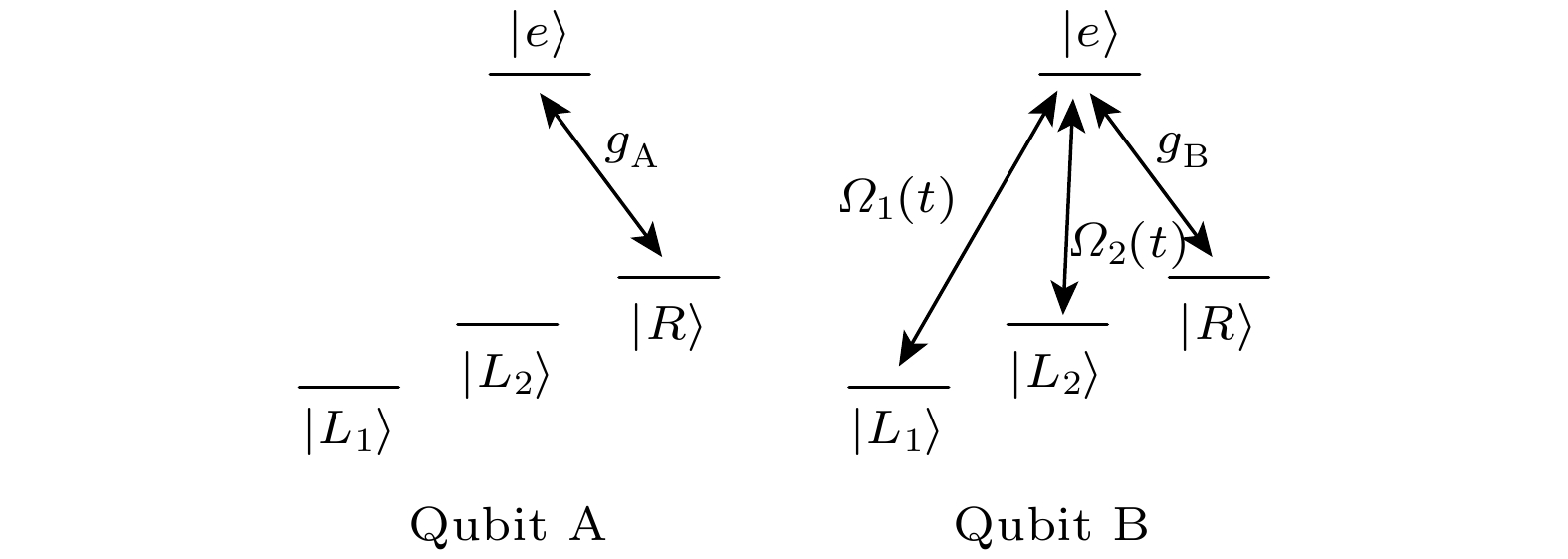


















 DownLoad:
DownLoad:
